Monuments in St John's Wood Chapel (St John's Wood Church)
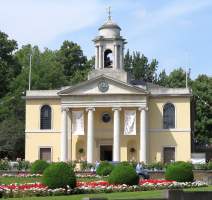
At the junction of the Finchley and St. John s Wood Roads, close by the station on the Underground Railway,
is the St John s Wood Chapel, with its burial-ground, in which a few individuals of note have been buried
St John s Wood Chapel, latterly St John s Wood Church, was put up in 1813-14, the work of the architect
Thomas Hardwick. The whole area of St John s Wood is named from the military order
of the Knights Hospitaller of St John of Jerusalem, who owned the land, thus attached to the priory at Clerkenwell.
But our chapel was built as a Chapel of Ease to St Marylebone Parish Church
(i.e. a subsidiary church conveniently located for some outlying habitations within the parish),
another work of Hardwick, and to be included on these pages in due course.
It occupies a prominent site, facing a major roundabout, and on the route to Lord s cricket ground,
where Thomas Lord had set up in a then-rural location in 1780.
The church, brick on the sides and rear, is faced with stone to the front, featuring a perfect ionic portico with a clock
in the pediment, and behind, a short, pretty tower with paired Tuscan column and a little cupola supporting a
weather vane. This rather delicate exterior, now painted a pale beige-yellow which enhances its lightness,
rather contrasts to the interior which is rather a cooler, more austere version of the classical ideal.
It seems this was rather altered by the Victorians, who removed many of the pews, and then restored
closer to its original state after WW2. The low columns, the boxed-in pews, and variety of monuments
on the walls give an ambience rather lost in many more empty classical churches.
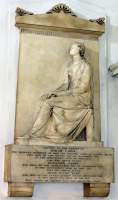
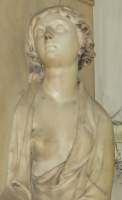 Chantrey's figure of Martha Capel.
Chantrey's figure of Martha Capel.
Our monuments then. There are two principal ones at the entrance to the chancel, 30-odd minor but interesting ones
around the walls, several with overseas links, and upstairs and unreachable behind the organ,
tantalisingly half in view, two more. We start with the two most showy:
- Martha Capel, d.1822, aged 18, and mother Eleanor Capel, d.1831, and father
John Capel, d.1846, with a seated figure of a a classical girl (pictured above), face upturned, resting her hands on her lap.
Her leg and face are in absolute profile, but her upper body is angled somewhat towards the viewer.
She is draped rather than clothed, with the enveloping shroud pulled back to emphasise her columnar neck,
exposing her upper chest and breast. Pediment with stylised wavy or leafy shapes above. An excellent work,
by no less a personage than Francis Chantrey, and dating from 1825.
- Children of Robert and Ann Agnes Gillespie: Grace Elizabeth, d.1832, Mary Ann, d.1833,
and Catharine d.1833, their ages being just 14, 12 and 7 respectively. The touching monument shows
the two older girls, the eldest almost a young woman, the second with the gawkiness of youth, standing on either side
of the youngest child, and placing a wreath of flowers on her brow. The two older girls are shown wearing diaphanous
dresses or night garments hanging gracefully to a little above the ankle, while the chubbier little girl
is in a shorter shift. All are barefoot. The arm of the second daughter, behind the 7-year old, has a long drape over it,
and the allusion of the shroud to be drawn over her is clear. A significant monument, poignant, and troubling
in the emotion it conveys. Samuel Nixon was the sculptor. To those familiar only with
his massive William IV at Greenwich, this will seem a remarkable contrast,
but is more familiar in style from his other ecclesiastical works, and the charming Beaufoy
panel shown on the page on this site dedicated to the sculptor.
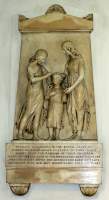
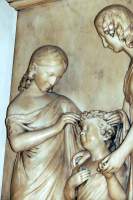
 Gillespie Sisters, by Samuel Nixon.
Gillespie Sisters, by Samuel Nixon.
On to the rest of the monuments. As not uncommonly the case, a particular style of tablet is favoured,
which here is to have a classical moulding behind the classical panel which is part of the wall.
We are lucky that several of the monuments are signed. The monuments date from when the church was
first put up through to the 1840s, with a single mid-Victorian example from 1860, so we break our usual date order
and consider them more or less alphabetically:
- Miss Mary Alston, d.1835, with a separate plaque beneath, to William Charles Alston, d.1838,
late a lieutenant colonel in the service of the Honourable East India Company on their Bengal establishment.
With a classical urn, strange fluted pilasters becoming much wider at the top, a pediment above with a frond,
and the dark backing carved to make a niche for the pot. It works, somehow.
- Jane Arbuthnot, d.1819, daughter of Robert Arbuthnot, Secretary to the Board of trustees
for the improvement of Manufactures in Scotland. With receding pilasters covered by knotted drapes, draped pot above,
delicate wreath below, on veined marble.
- Patrick Bartlet, d.1830, of Nottingham Place and formerly resident in the Island of Carriacou
in the West Indies, the first of three monuments to this family. A simple chest tomb end with thick base and pediment,
no border. Signed by Physick sculp, Park Terrace. There were several sculptors by this name, who according to Gunnis,
the authority, were all related, and spanned from the late 1810s through to after 1870. Benjamin Bond s tablet below is
by E. Physick, at the same address so perhaps this piece is by the same artist.
- Anne Bartlet, d.1844, wife of Patrick Bartlet, with a monument of the same design,
and hence possibly by Physick. I could not read the signature but the address is T?ENT works IER St Westminster.
- Isabella Bartlet, d.1821, wife of Patrick Bartlet, of Nottingham Place, white marble with
fluted pilasters, high relief pot with drapes above, on dark obelisk shaped backing. Fronds on apron beneath and a
tiny shield of arms. Signed by [George] Lupton, New Road.
- Charles Binny, d.1822, formerly of Madras. Fluted pilasters, draped pot, fronds on apron on either side
of the small shield of arms a copy of the Isabella Bartlet monument of the previous year, and again by Lupton.
- Susannah Maria Flint, d.1825, with fluted pilasters, a high relief pot with near-symmetrical drapes,
against a dark obelisk shaped backing, and apron with wreath. A near-repetition of the design of the Charles Binny and
Bartlet tablets, but the former lacks the backing. Hence presumably by Lupton.
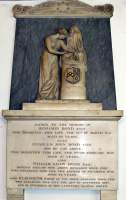
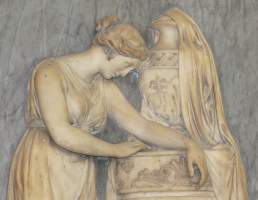 Benjamin Bond monument, by E. Physick.
Benjamin Bond monument, by E. Physick.
- Benjamin Bond, d.1832, wife, and two sons. With a shelf above supporting an attached sculpture
of a girl leaning against a plinth supporting a pot. The usual crossed legs, but her pose is less coventional,
leaning one lower arm on the plinth, and her other hand, her head bowed, in front of or against the pot, baroque
rather than purely classical. The plinth bears a coat of arms, the pot is decorated and draped. Decent work, signed
by E. Physick, Sculp. Park Terrace according to Gunnis, this is Edward William Physick.
- Captain Hugh Cathre, d.1838, and various others related via his wife Adelaide Margaret Cathre,
d.1879, daughter of Captain John Cooke of Calcutta, who is commemorated on the apron.
Severe monument with boxy pediment above enclosing a bible with a tilted cross behind,
large fluted brackets below, odd little curlinesses on each side, which are too small to be more than an accent.
- Catherine Chatterton, d.1829. Plain with base and pediment.
- Martha Maria Cherry, d.1819, wife of George Frederick Cherry,
Senior Judge to the Honourable East India Company, of the Court of Appeal at Benares.
Within an oval on a rectangular backing, with small pediment and large ears bearing stylised flower designs.
This is the work of R. Blore Junior, of Piccadilly, a prolific sculptor together with R. Blore Sr
- see this page.
- George Cherry, d.1813, Chairman of the Victualling Board, with oval surround on rectangular plaque,
small pediment and large ears, as per Martha Maria Cherry (later). Presumably again by Blore as the design is the same.
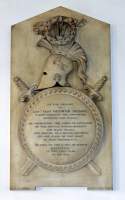 The George Deare monument, by C. H. Smith.
The George Deare monument, by C. H. Smith.
- Lieut. Gen. George Deare, d.1823, commander of the Corps of Artillery on the Bengal establishment
for many years. Inscription on a shield, with crossed swords behind, and a Corinthian helmet above, plumed,
and with wreath partly over that. Rather dramatic and recalls brave hoplites battling Persians.
Signed C. H. Smith, of 5 Portland Road. This is Charles Harriott Smith, one of a dynasty of sculptors,
who used emblems similar to this striking design elsewhere indeed it is surprising that given the popularity
of this sort of design as a decoration for buildings, that it is not more common on monuments.
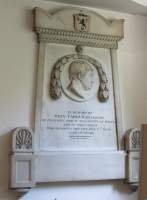 Rouw's portrait roundel of John Farquhar.
Rouw's portrait roundel of John Farquhar.
- John Farquhar, d.1826, of Fonthill, Wiltshire, with a medallion profile portrait in high relief.
In the manner of a noble Roman, and in their mode, with no attempt at flattery. A half wreath of something like
laurel leaves and berries hangs round the upper part of the medallion, and above is a curved, eared pediment
with a small shield of arms, and a similar repeating design to William Richardson (who died later) is beneath that.
A thin tapered border rather than pilasters to the sides, and a thick base with brackets rising up on either side
with minor decoration, all crisply cut. The sculptor was Peter Rouw the Younger, whose work may be seen in a number
of churches across Southern England, and in Birmingham Cathedral.
- Jane Farquhar, d.1834, and husband Robert Farquhar, d.1836, of Portland Place,
Newark County Renfrew, and of Antigua and Grenada. With shelf, rounded pediment, thick base, and minor wavy carving,
with a tiny flower centre. The work of Charles R. Smith of 37 Gloucester Place, New Road, a significant sculptor with
monuments in Durham and Chichester Cathedrals.
- Susanna Gordon, d.1831, plain with narrow shelves, and a pot draped in two leafy branches,
not uncommon as a design, but the only one in this church.
- John Gosling, d.1848, and wife Elizabeth Curtis, d.1829, youngest daughter of
George Cherry, and two younger Goslings, George Robert Gosling, d.1825, of the Madras Civil Service,
and Elizabeth Rosanna Gosling, d.1848. Plain, with a carved coat of arms above the shelf.
- John Josiah Holford, d.1836, of York Place Portman Square, and Kilgwyn in County Carmarthen,
and wife Jane Margaret, d.1830. A more ambitious panel with pilasters decorated with bluebell designs
in a light, almost Louis XIV manner, large pot on top, decorated and with asymmetrical drapes,
not entirely convincing in the folding, and frond and sprig of perhaps mistletoe on the apron along with the shield
and motto. It is the work of the Patent Marble Works, Westminster, who made a number of monuments, the actual carvers being
unfortunately anonymous.
- Elizabeth Jane Humby, d.1847, with carved entablature under the pedimental shelf,
and also carving on the brackets.
- Mary Lawrence, d.1815, husband Richard James Lawrence of Irwin, Jamaica,
with second panel to James Lawrence, son, d.1840, and another son, Frederick Augustus Lawrence,
who died at Carlsbad in Bohemia in the same year. Plain with shelf top and bottom.
- Anna Maria Lushington, d.1816, aged just 8, daughter of William Lushington and wife
Anna Maria. With upper shelf bearing a draped pot, and in place of pilasters, knotted hanging drapes.
On a black marble backing veined with white.
- Francis Anthony(?) Morris, d.1842. Among all the correct Classical wall monuments,
is this single cartouche, defiantly Baroque, rather worn, with curly borders, and a second detached border of leafinesses,
becoming crossed branches at the base with a bit of ribbon, and arms on mini cartouche and motto above.
Elegant, and providing a not unpleasing variety from the severe classical surrounds and other monuments.
- Lieutenant General Sir John Murray, Baronet, d.1827 at Francfort on the Mayn [Frankfurt], and
wife Dame Anne Elizabeth, d.1848, decorated with ribbons and curls on pediment and ears, and with a
carefully carved roundel of arms including two tiny figures of Roman soldiers. Naturalistic but entirely imaginary
flowers on the brackets.
- John Robert Parker, d.1842, and wife Catherine, d.1832, and relatives.
Blocky monument without detail, heavy shelf beneath and on the equally heavy pediment, coat of arms in a roundel,
and cross on top.
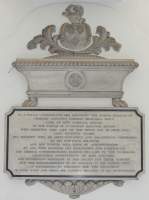 Charles A. G. Pieschell monument, by Thomas Sams.
Charles A. G. Pieschell monument, by Thomas Sams.
- Charles Augustus Godfrey Pieschell, d.1821, of New Norfolk St, who supported numerous charitable
institutions in Britain, as well as establishing an asylum in his native city of Magdeburg in Germany for the
education of poor boys and girls . Panel with black border supporting a carefully carved casket in high relief
with with fronds and a shield above, lion s feet supports, and floralities below the panel forming a short apron.
Signed by [Thomas] Sams, Downes St, Piccadilly, a monumental mason producing work from 1810 through to the 1830s.
- Augustus Fredrick Pieschell, d.1822, of Wandsworth Common and of Ballards in Surrey.
Same design as Charles Pieschell, also by Thomas Sams.
- Ellen Powell, d.1860, the only mid-Victorian panel in the church, with the inscription as a scroll
on a plain background, also white, with a cross with a knot on it above.
- John Simpson Rawson, Lieutenant of the 63rd Regiment Bengal, killed at the battle of Sobraon, 1846,
and father Sir William Rawson d.1827. Plain, cut to shield shape, on plaster Gothic backing.
- William Richardson, d.1838, wife Ann, d.1825, and Ann Garner Richardson,
a grandchild, d.1823 in infancy. Tapering marble block with big base, flowers on the brackets, minor decoration
on entablature below plain pediment. Very crisply cut. Another work by Peter Rouw the Younger, who we met above
as sculptor of the John Farquhar monument.
- Robert Woodmass, d.1820, of Montague Square, and wife unnamed, d.1840. Elegant casket end with
outward leaning pilasters, slightly curved pediment with boldly carved floral decorations, nice lamp on top with drapes,
cross and coat of arms below.
- Charlotte Stratton, d.1819, daughter of William Stratton, Member of Council at Bombay, and addition to
Jane Stratton, her mother, d.1830. Nice calligraphy, delicate border, shelf above, with little pot,
and curls below. The heavy drapery on the pot subtracts somewhat from the lightness of the piece.
- Finally on the ground floor, we note a WW2 memorial plaque with painted gilded border.
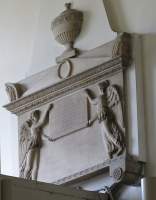 The tantalisingly inaccessible Charles Morgan monument.
The tantalisingly inaccessible Charles Morgan monument.
Upstairs, and not gettable at, is Lieutenant General Charles Morgan, d.1819, of the East India Company.
A nice thing, the plaque being held up by two winged angels, shown more or less symmetrically and in profile; above, a perfect classical urn; and flanking it,
strange faces on the pediment ears.
Also up there is Eliza Kyd, d.1819, and husband Lieutenant General Alexander Kyd,
with Egyptian design pattern along the top and a pediment made of two curved scrolls with some petalled object between,
and a higher tier bearing a rounded pediment with two linked wreaths. But the rest of the monument cannot be seen from
downstairs.
Outside, in the narrow yard alongside the church, are a solid chest tomb, and a casket, the former of which is to
one David Pike Watts, d.1816, a name recorded by the Founder himself of the Madras system of education
[i.e. Andrew Bell] as the first person who actually introduced that system into practice in England.
The corners of this tomb are decorated with charming little pairs of kneeling angels in high relief.
To the other side of the church, in the front yard, is a full size modern statue of St John,
wearing an animal pelt, walking forward with hand raised; signed H.F. [19]78. This is a work by Hans Feibusch,
a German painter and sculptor of Jewish origin who came to England as a refugee,
and whose religious sculpture can be seen in Ely and Chichester Cathedrals. His mural work can be seen more widely, including
in some London churches.
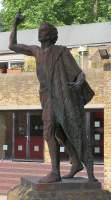 Hans Feibusch's statue of St John (modern).
Hans Feibusch's statue of St John (modern).
Outside, in the middle of the busy roundabout, is the notable War memorial sculpture of St George and the Dragon, by
C. L. Hartwell.
With many thanks to the Church authorities for permission to show pictures of the monuments inside; their website is
http://www.stjohnswoodchurch.org.uk/.
Top of page
Thomas Hardwick // Monuments in some London Churches // Churches in the City of London // Introduction to church monuments
Angel statues // Cherub sculpture
London sculpture // Sculptors
Home
Visits to this page from 8 Sept 2012: 17,790


 Chantrey's figure of Martha Capel.
Chantrey's figure of Martha Capel.


 Gillespie Sisters, by Samuel Nixon.
Gillespie Sisters, by Samuel Nixon.
 The tantalisingly inaccessible Charles Morgan monument.
The tantalisingly inaccessible Charles Morgan monument.
 Hans Feibusch's statue of St John (modern).
Hans Feibusch's statue of St John (modern).